A delightful walk from Arona
Posted by Sally Whymark
This walk is a favourite with our group of walkers, and many others too. However, I had not done it for some time, as it lacks shade and therefore in the summer we avoid it. So it was a pleasure to do it yesterday, September 21st, with the cooler temperatures we are now experiencing. It is remarkable for its excellent views, and landscapes, as well as having quite a lot of nature and cultural interest if you keep your eyes open
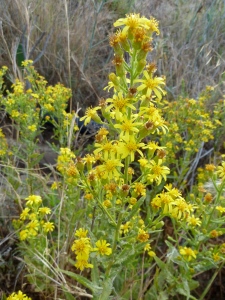
Stink Aster (Dittrichia viscosa) is a widespread plant of waste ground. It provided the majority of the colour on this walk at this time of year.
We started the walk from the church by the reservoir on the right of the TF-51 as you leave Arona towards Vilaflor. There is a little parking there, and there is a little also at the start of the path 250m up the road on the left. A track leaves the road there heading down to a barranco crossing and soon after a signpost points to footpaths going in two directions. We went to the right to start the walk, and came back on the other path.
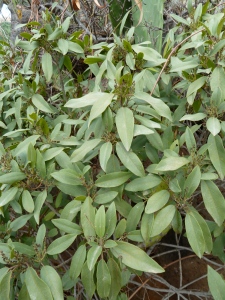
Moralito, an endemic form of buckthorn, (Rhamnus integrifolia) beside the path beyond the first old farmhouse.
Although not as well marked as some paths, the path is very well walked and therefore very clear. It heads up on the left-hand side of the Barranco del Ancón, with lovely views into this scenic ravine. Soon an old abandoned farmhouse appears on the crest and the path heads towards this. At the farmhouse the path goes to the right, back to the edge of the barranco, and in the next short stretch I saw two interesting endemic plants I had never before noticed in this spot, Moralito, an endemic of the buckthorn family, (Rhamnus integrifolia) and Mataperros or Tenerife wax plant (Ceropegia dichotoma). Both were at the side of the path.
After a steep bit of the climb, which is quite rough underfoot, we reached an old track passing some fincas on the right, and afterwards, the ‘Refugio’ on the left, which is open in the winter for refreshments, but still closed for the summer at the moment. Soon after this, and before an old farmhouse on the left of the track, there is an old threshing circle on the ridge, and it is from here you need to look to the left for the path to cross the Barranco del Rey. There are some cairns, and in fact there are two small alternative paths by which to go down, but only one path up the opposite side.
The path on the far side leads past another abandoned old farmhouse to a large threshing circle in the col between the peaks of Roque Imoque to the south and Roque los Brezos to the north. Here we met the GR131 long-distance footpath which runs from La Esperanza in the north to Arona in the south. So from here on the footpath was better marked, with red and white parallel lines painted on rocks, etc. After admiring the new view, to the west coast, down to Fañabe and the Playa del Duque, we turned left to go downhill on the path.
This stretch of path, exposed to the west coast winds and mists was noticeably different in humidity and hence the plants that were growing. The rocks and many of the older plants are covered in a great range of lichens of different colours and types, as well as minute endemic flowering plants of the Crassulacea family, Monanthes pallens. It was great to see that many plants, especially the Purple-flowered spurge, (Euphorbia atropurpurea) and the Cruzadilla or Reflexed St John’s wort (Hypericum reflexum) were already producing fresh leaves after the summer, though it is too soon for flowers.
The path descends towards the Roque del Conde, the impressive table-top mountain you can see from the south coast resorts, though from its other side the top looks less flat. On the way it passes a dip in the landscape where an old farm is situated, complete with abandoned farmhouse, caves carved in the pumice rock for animal sheds and storage, and even for a home, a threshing circle, and a water channel to collect rainwater and lead it to a covered cistern.
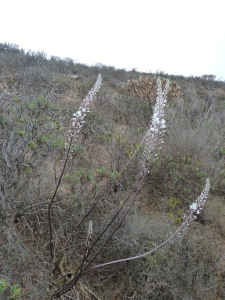
Sea squill (Drimia maritima) flowers in late summer/early autumn. This was an exceptional, many-flowered specimen. Usually they have just one spike of flower.
The path continues downhill and we passed a number of Sea squill (Drimia maritima) which the spanish call ‘Cebolla del mar – literally ‘sea onion’, as it has a round bulb. We reached the col beneath the Roque del Conde and here we followed the red/white signage by turning left down the valley, heading towards Arona.
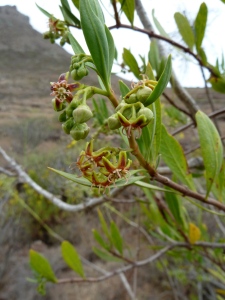
The flowers of Cornical (Periploca laevigata). On the west side of the mountains it was flowering, while on the east side the remarkable seed pods were still splitting and releasing the fluffy parachuted seeds.
As we approached the ravine of the Barranco del Rey for the second time, at the foot of the valley we had a choice of routes to cross it. The first footpath turning left leads to a steep zig-zag descent directly opposite the place where the path ascends, however we walked a further 50 m or so to turn left onto another gentler path down into the barranco, and then walked a little way up the streambed to join the ascending path. This brought us down near to a part of the ravine which was a very narrow gorge where some rock-climbers were in action.
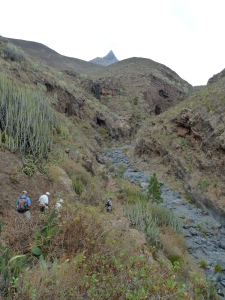
Descending into the Barranco del Rey for the second time. The pointed mountain in the distance is Roque Imoque.
Making our way up out of the ravine I was glad to see that the two further specimens I knew in this area of the Moralito, a fairly scarce Tenerife endemic, were thriving, and I also saw a new younger plant too, which I had never before noticed. The path doubles back to give great views of the ravine before passing another old farmhouse and continuing to join the track we set out on.
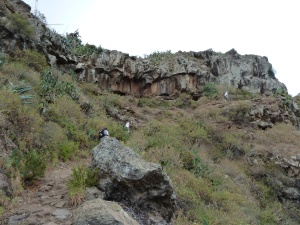
The path out of the Barranco del Rey towards the end of the walk. A large plant of Moralito can be seen under the cliff towards the top near the front walker.
The walk was 7.77km/ 4.86m long and involved 420m / 1379 ft of climbing. It took our group of 6 walkers 3 hours.
About Sally Whymark
When I retired and moved out to Tenerife a few years ago, one of the things I really wanted to do was go walking in the mountains. The scenery is very dramatic, and varied. The views are amazing. The native birds and butterflies and other fauna are remarkable. But the flowers - they're just stunning. Little did I know how this would fire up my interest in plants. While living in England, I had always had an interest in flowers and plants, indeed I ran a plant nursery with my husband for many years, but had not spent a great deal of time pursuing botany. But when walking in Tenerife, I noticed all the unfamiliar shapes of the local flowers, and longed to find out more about them. There are literally hundreds of species endemic to just Tenerife (or even just one part of it), the Canary Islands, or Macronesia (the Atlantic Islands, including Madeira, Canaries and Azores). They are so exciting, and so many of them are really showy as well. So I have started this blog to share with you my excitement at all the great sights I see when walking in Tenerife. I hope you'll enjoy it - and want to come here and experience it for yourself.Posted on September 22, 2013, in Botanical interest, South Tenerife, Walks in Tenerife and tagged Arona, Barranco del Ancón, Barranco del Rey, Cebolla maritima, Ceropegia dichotoma, Cornical, Dittrichia viscosa, Drimia maritima, hiking, Mataperros, Moralito, Periploca laevigata, Rhamnus integrifolia, Roque de los Brezos., Roque del Conde, Roque Imoque, Sea squill, senderismo, Stink Aster, Tenerife, walking. Bookmark the permalink. 2 Comments.
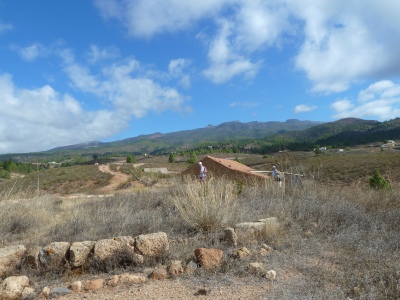
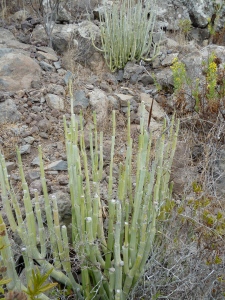
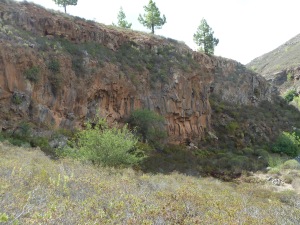
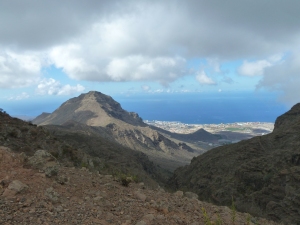
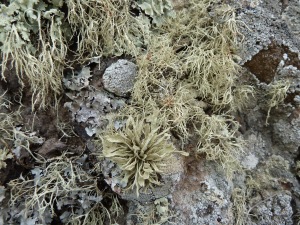
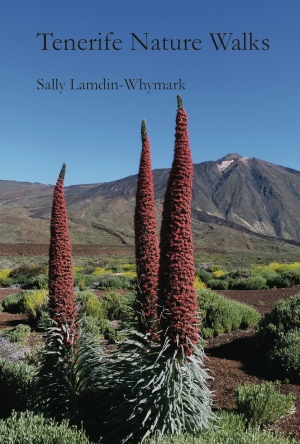
Hi Sally, I have heard people using the name Roque Imonde for Roque Imoque, is this correct? Thought you might know, I find references to both on line 😀
I know that both the name Roque Imoque and Roque Imonde are on different official maps from different editions. Not sure if one is an error. On the signs recently put up in the area it is called Roque Imoque.